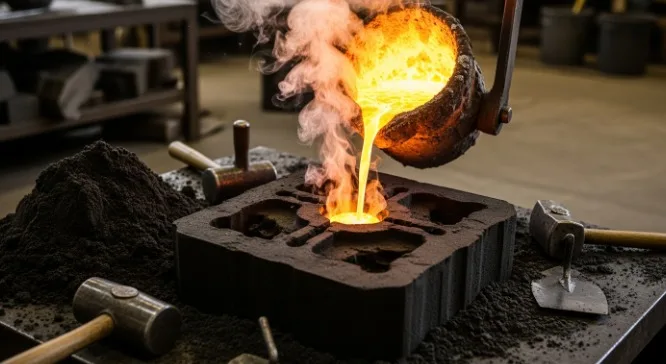Cost Optimization Strategies for Small-Batch Custom Steel Casting
Small-batch custom steel casting presents unique challenges for manufacturers and engineers. Unlike high-volume production runs that benefit from economies of scale, small batches often face disproportionately high per-unit costs due to setup expenses, tooling investments, and foundry minimums. However, with strategic planning and the right approach, companies can significantly reduce costs while maintaining quality and meeting delivery requirements.
Understanding the Cost Structure
Before diving into optimization strategies, it’s essential to understand where costs accumulate in small-batch steel casting projects. The primary cost drivers include:
Tooling and Pattern Costs: Creating molds, patterns, and cores represents a substantial upfront investment that must be amortized across fewer units in small batches.
Setup and Preparation: Foundries require time to configure equipment, prepare materials, and set up quality control processes, regardless of batch size.
Material Costs: Steel alloys, especially specialty grades, may need to be purchased in minimum quantities that exceed small-batch requirements.
Labor Intensity: Small batches often require more hands-on attention and cannot fully leverage automated processes.
Quality Assurance: Testing and inspection costs remain relatively fixed, making them a larger percentage of total costs for smaller quantities.
Strategic Design Optimization
The most impactful cost reductions often begin at the design stage, well before metal meets mold.
Design for Manufacturability should be the cornerstone of any cost optimization effort. Simplifying geometries, minimizing undercuts, and reducing the need for complex cores can dramatically decrease tooling costs. Consider consolidating multiple components into single castings where possible, as this can eliminate assembly costs while reducing the total number of patterns required.
Standardizing features across different parts in your product line allows for shared tooling elements. Universal mounting points, common wall thicknesses, and standardized connection interfaces can reduce the total tooling investment when producing multiple related components.
Tolerance rationalization represents another significant opportunity. Every unnecessarily tight tolerance adds cost through increased machining requirements, more complex tooling, or higher scrap rates. Review specifications carefully and relax tolerances wherever performance allows.

Smart Material Selection
Material costs can be optimized without compromising performance through strategic alloy selection and purchasing approaches.
Alternative alloy evaluation often reveals opportunities to use less expensive steel grades that still meet performance requirements. For example, carbon steel might suffice where low-alloy steel was originally specified, or a more common alloy grade might substitute for an exotic one.
Collaborative purchasing with other companies or through industry consortiums can help achieve better pricing on specialty alloys by combining smaller orders into larger purchases. Some foundries also offer material pooling arrangements where multiple customers share the cost of minimum steel purchases.
Scrap and return material programs can provide cost savings when foundries can incorporate clean scrap from previous jobs or return sprues and risers to the melting process.
Tooling and Pattern Strategies
Since tooling represents such a significant portion of small-batch costs, optimizing this investment is crucial.
Modular tooling systems allow patterns to be reconfigured for different but related parts, spreading tooling costs across multiple projects. This approach works particularly well for families of components that share common features.
Progressive tooling development involves starting with simpler, less expensive patterns for initial prototypes and low-volume production, then investing in more sophisticated tooling only when volumes justify the expense.
Shared pattern programs with foundries can reduce individual customer costs when multiple clients need similar components. Some foundries maintain libraries of standard patterns that can be modified for specific applications at lower cost than creating entirely new tooling.
3D printed patterns and cores have revolutionized small-batch economics by dramatically reducing pattern lead times and costs, especially for complex geometries that would be expensive to machine traditionally.
Foundry Partnership Optimization
The choice of foundry partner and the structure of that relationship significantly impacts small-batch costs.
Right-sizing the foundry is critical. Large foundries optimized for high-volume production may not be cost-effective for small batches, while smaller, specialized foundries often offer better economics and more flexible service.
Batch timing coordination can help achieve better pricing. Foundries may offer discounts for non-urgent work that can be scheduled during slower periods or combined with other jobs for more efficient furnace utilization.
Long-term partnership development often yields cost benefits as foundries become more familiar with your requirements and can streamline processes accordingly. Consistent relationships also provide leverage for negotiating better rates and priority scheduling.
Process Selection and Flexibility
Choosing the right casting process for small batches requires balancing tooling costs, per-piece costs, and quality requirements.
Investment casting often provides the best economics for complex, high-precision small parts, as the tooling costs are relatively low and the process can achieve tight tolerances without extensive machining.
Sand casting with 3D printed patterns offers flexibility and lower tooling costs for larger components, though per-piece costs may be higher due to increased machining requirements.
Hybrid approaches combining different processes for different features of the same part can optimize costs while meeting all performance requirements.
Quality and Testing Optimization
Quality assurance costs can be managed without compromising standards through strategic approaches to testing and inspection.
Risk-based inspection programs focus more intensive testing on critical features while using sampling approaches for less critical characteristics. This reduces inspection time and costs while maintaining confidence in part quality.
Statistical process control implementation allows foundries to reduce inspection frequency as process capability is demonstrated, lowering per-piece quality costs over time.
Collaborative quality planning with foundries can identify the most cost-effective combination of in-process controls and final inspection to meet your requirements.
Timing and Scheduling Strategies
Strategic timing decisions can significantly impact small-batch costs.
Flexible scheduling allows foundries to fit small batches into production schedules more efficiently, often resulting in better pricing for customers who can accommodate longer lead times.
Campaign production involves producing multiple small batches of different parts simultaneously, sharing setup costs and achieving better furnace utilization.
Inventory planning helps balance the costs of holding finished goods against the economies available from slightly larger batch sizes.
Technology Leverage
Emerging technologies offer new opportunities for small-batch cost optimization.
Digital twin modeling can reduce the need for physical prototypes and minimize the risk of costly design changes after tooling is complete.
Simulation software helps optimize gating and risering systems, reducing material waste and improving yield.
Automated finishing systems are becoming more accessible to smaller foundries, potentially reducing labor costs for post-casting operations.
Implementation Framework
Successfully implementing these cost optimization strategies requires a systematic approach:
Start with a comprehensive cost analysis of your current approach, identifying the largest cost drivers specific to your application. Prioritize optimization efforts based on potential impact and implementation difficulty.
Engage with multiple foundry partners to understand different approaches and pricing structures. What works best for one application may not be optimal for another.
Consider the total cost of ownership, including not just piece price but also inventory carrying costs, quality risks, and supply chain complexity.
Develop relationships with foundries that view small-batch work as an opportunity rather than an inconvenience. These partners are more likely to invest time in optimization efforts that benefit both parties.
Measuring Success
Establish clear metrics to evaluate the effectiveness of your cost optimization efforts. Beyond simple piece price reduction, consider improvements in lead time predictability, quality consistency, and total project costs including engineering time and inventory requirements.
Regular reviews of actual costs against projections help identify opportunities for further optimization and ensure that cost reduction efforts don’t inadvertently compromise other important objectives.
Conclusion
Cost optimization in small-batch custom steel casting requires a holistic approach that considers design, materials, processes, and partnerships. While small batches will always face economic challenges compared to high-volume production, thoughtful application of these strategies can achieve substantial cost reductions while maintaining quality and delivery performance.
The key is to start early in the design process, develop strong foundry partnerships, and continuously evaluate opportunities for improvement. Companies that take a strategic approach to small-batch casting costs often find that they can achieve competitive piece prices while maintaining the flexibility and responsiveness that small-batch production provides.
Success in small-batch steel casting isn’t just about finding the lowest price—it’s about optimizing the entire value proposition to achieve the best combination of cost, quality, delivery, and service that meets your specific requirements.

